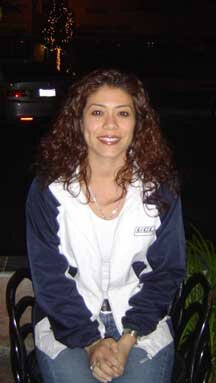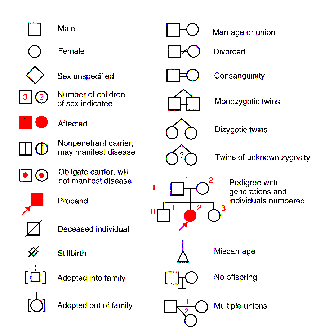BIO 442 MENU
syllabus 
1 - genome
2 - mutate
3 -cell cycle
4 - karyotype
5 - chromoabn
6 -sex-determ
7 -prenatal
8 - mendelian
9 - complex
10 - non-trad
11 - clinical
12 - newborn
13 - teratog 
14 - linkage
15 - DNA prof 
16 - quanti 
17 - links
18 - quizzes
(full title of lecture appears in status bar on the top or at the bottom of your window)
On Sunday February 5 - 9:30 am to 4:30 pm at UCLA, Covel Commons, Grand Horizon Room, the UCLA Center for Society and Genetics, the UCLA Institute for Stem Cell Biology and Medicine, and the UCLA School of Law present:
Stem Cells: Promise and Peril in Regenerative Medicine
This free event is open to the public. It is co-sponsored by the David Geffen School of Medicine at UCLA; Mattel Children's Hospital at UCLA; The Greenwall Foundation; UCLA Anderson School of Management; UCLA College of Letters and Science; UCLA School of Dentistry; UCLA School of Public Affairs, and the UCLA School of Public Health
For more details
Topics and Speakers:
www.socgen.ucla
Biology 442 - Human Genetics
Lecture Syllabus - Spring 2006
|
Instructor: |
Carol D. Guzé, Professor of Biology and Ph.D. Medical Geneticist, ABMG |
|
|
Office: |
NSM A-135 |
|
|
Telephone: |
||
|
Lecture Room |
NSM D129 |
|
|
E-mail: |
||
|
Office Hours: |
Monday 1:00 -4:00 p.m. |
|
|
Website: |
||
|
Course Prerequisites : |
Upper division cell biology and genetics |

The Bio 442 Class Spring 2006


Dr. Carol Guzé, Professor and Ms Sonia Nuñez, Teaching Assistant
TEXTBOOKS:
Genetics in Medicine 6th Edition, by Nussbaum, McInnes & Willard and Color Atlas of Genetics, 2nd edition by Passarge.
T = Thompson, P = Passarge
Topics |
|
Chapters/Pages in Text |
|
Comments |
|
The The Genome, DNA, Chromosomes and Gene Structure |
P 20-77, 80-83, 170-183 |
|
||
|
Mutations: Somatic and Germinal, Single Gene and Chromosomal |
P 68-73, 76-7, 316-35 |
Gene mutations, cancer, gonadal mosaicism and sporadics, polymorphisms, allelic and locus heterogeneity, VNTRs, STRs |
||
|
Cell Cycle, Mitosis and Meiosis and Non Disjunction |
P 112-121 T Ch 2, 9 |
|
||
|
Karyotyping |
P 184-7, 122-3, 190-5 |
Cells and tissues used and identification techniques: banding methods, high resolution banding and fluorescence in situ hybridization (FISH) and microdeletion |
||
|
Chromosome Abnormalities: Autosomes and Sex Chromosomes |
P 188-202, 314, 334-5, 400-5 |
Changes in number |
||
|
Sex determination |
P 386-393 |
X and Y chromosomes, pseudoautosomal region, X inactivation, SRY/TDF, DSS (DAX), SOX 9, abnormal sexual development |
||
|
Prenatal Diagnosis and Genetic Counseling |
T Ch 18, 19 |
|
||
|
Patterns of Inheritance |
See center section of Clinical Case Studies and |
|
||
|
Mendelian Genetics |
P 132-43, 378 |
AD, AR, XD, XR, CD: Patterns of Mendelian inheritance |
||
|
Quantitative Genetics |
P 158-9 |
Probability, Hardy-Weinberg and gene frequencies, risk assessment, Bayes Theorem, gene mapping (LOD scores) |
||
|
Multifactorial inheritance |
P 152 |
Height, skin color, NTD, cleft lip/cleft palate, common diseases |
||
|
Non Traditional Inheritance |
P 78, 124-31, 314, 394-8, 404 |
Microdeletion Syndromes(contiguous gene syndromes, segmental aneusomy) |
||
|
Clinical Genetic Disorders |
P 276, 284, 316-7, 334-49, 352-61, 380-2, 384-5 |
Hemoglobinopathies, blood types, enzyme deficiencies, lysosomal storage diseases, peroxisomal diseases, CF, NF1, OI, DMD/BMD, De Lange, TSD, PKU, FH, galactosemia, Marfan, achondroplasia, FGFR's, skeletal disorders, hemochromatosis, etc. |
||
|
Newborn and Carrier Screening and Gene Therapy |
T Ch 13, 14, 20 |
PKU, galactosemia, sickle cell, hypothyroidism; Tay-Sachs, hemoglobinopathies, cystic fibrosis. Enzyme replacement and gene therapy. |
||
|
Teratogens and Development |
T Ch 17 |
Phenocopies, maternal diabetes, Fetal Alcohol Syndrome (FAS/FAE), Seizure medications, viruses, hyperthermia |
||
|
Linkage and Chromosome Mapping |
P 144 |
Techniques past and present to locate genes on chromosomes |
||
|
DNA Profiling |
T Ch 6, 7 |
Paternity and identity testing and forensics |
Course Objectives
(These objectives will be assessed by examinations)
At the end of this course you should know about:
- Chromosome, genome structure and functions.
- Chromosome abnormalities: how they arise, risks of occurrence and their detection
- Prenatal tests and screening for genetic defects
- Non-traditional inheritance: mosaicism, microdeletion syndromes, uniparental disomy, genomic imprinting, trinucleotide repeats, mitochondrial disorders
- The events in sexual development and some genetic abnormalities
- Several common single gene disorders, their cause, diagnosis, and recurrence risks
- How and where new mutations arise and the possible consequences: somatic and germinal
- Common multifactorial traits and recurrence risks
- Common teratogens and the embryopathies they produce
- The use of DNA fingerprinting in identification of individuals
- The current status of prenatal testing, newborn screening, carrier testing, genetic counseling
- How to construct a pedigree and analyze it.
Evaluation
Evaluation |
|
Points |
Approximate Date |
|
Weekly Quizzes |
120 |
Weekly |
|
|
Family Pedigree |
|
10 |
February 15 |
|
Mitosis and Meiosis diagram |
20 |
February 22 |
|
|
Chromosome Abnormality Paper |
30 |
March 8 |
|
|
Midterm exam |
120 |
March 22 |
|
|
Pedigree and Analysis |
30 |
April 12 |
|
|
Genetic Disorder Paper |
30 |
May 3 |
|
|
Final exam |
120 |
May 17 |
|
|
TOTAL |
480 |
|
Suggestions for Studying
The best way to study is to read or at least peruse the web lecture before class. Print out the web lecture notes (using "landscape") and take notes during lecture on the reverse side of the print out of the lecture. Ask questions during lecture when you do not understand. And most importantly, come to office hours regularly to go over your notes and to clarify your understanding. If you cannot come to office hours I will arrange a special time for you.
Extra Credit
Extra points can be earned by attending specific genetic lectures or workshops at neighboring institutions, answering questions in lecture or finding errors in the web site. Up to 20 extra points can be earned.
Quizzes
There will be weekly quizzes. The total points from quizzes will be equal to one midterm.
Grade Assignments
|
A B+ C+ D+ F |
100 - 92 % 89 - 87 % 79 - 77 % 69 - 66 % < 60 % |
Assignment Directions
Grading on assignments and test essay questions is based on your command and control of the subject matter, the organization (proper paragraphing, headers, etc.), clarity, accuracy, your ability to express yourself clearly in standard written English using your own words. Please do not copy text from your sources and write at the level of your audience....a biology major with the prerequisites to this course....begin with the basics.
Unless the information you include is yours or common knowledge, cite the sources. All references used should appear alphabetically at the end of your papers and should be written in standard journal format. Use the format that is used by your textbook when it lists references.
Number the references and if citing information not generally known, place the number of the reference within the text of your paper. When you cite information from a book give the page number(s) from which the information came. Ask me or go to a biological journal to see how journal articles include references within the text. For example, do not put the reference at the end of the paragraph, instead say, "Vickers (1999) found that........." or after a statement refer to the source. READ a journal article to see how it is done.
Do not use quotation marks...rephrase the information. Use your textbook(s) as a reference and books or articles you read. List only the references you have read. DO NOT list references referred to in your text or in other references....those are secondary references. And do not depend on the internet.
Style manuals can show you how to cite non standard references such as those from the Internet. Please be cautious in the use of Internet sources. Anyone can say anything they want and there is no peer review! The correct way to cite Internet sources is described in the newer Style Manuals. The basic entry should include the following elements: Author. The author's name, last name first. Date of publication. The year of Internet publication or the year of the most recent update in parentheses followed by a period. Title. The title of the document or subject line of the message, in quotation marks. End with a period inside the quotation marks. Address. The URL, in angle brackets, or other retrieval information. Date of access. In parentheses, followed by a period: An example: Shade, LR (1993). Gender issues in computer networking.
The correct way to cite an OMIM reference is described in detail under "Citing OMIM in the literature." You can get there by going to the OMIM home page. The title of the page is included as seen in the following example: Online Mendelian Inheritance in Man, OMIM. TM. Johns Hopkins University, Baltimore, MD. MIM Number:130050:1996. Ehlers-Danlos syndrome, Type IV, autosomal dominant. World Wide Web URL: http://www.ncbi.nlm.nih.gov/omim/
Citing a specific entry in OMIM:
(Note! Many times it is most appropriate to cite the actual journal article for the data of interest.)
Online Mendelian Inheritance in Man, OMIM (TM). Johns Hopkins University, Baltimore, MD. MIM Number: {MIM number}: {Date last edited}: . World Wide Web URL: http://www.ncbi.nlm.nih.gov/omim/
REFERENCE MATERIAL MUST BE SUBMITTED WITH THE PAPERS YOU WRITE.
BEFORE you begin to compose or write, read the material you have collected many times until you really understand it. Then think it over and, if possible, talk it over with someone. You can practice by telling your family, friends and/or colleagues to be certain you can convey the information to them. After you have thought the information over and distilled it to its essence, organize it in your head in a logical sequence. Then write a rough draft. Remember, your audience is undergraduate biology majors. Most of all, remember to KEEP IT SIMPLE. Do not use complex words or sentences when simple ones will do. Select only relevant information. Do not overwrite and do not repeat yourself. Do not have run on sentences with too many ideas.
Remember to break the information down into paragraphs. A paragraph has a central idea to convey with supporting evidence. A paragraph has a topic sentence followed by supporting data and a closing. You can use headers to direct the readers attention to each section of information, if you like. Some examples are: Historical Background, Description of the Syndrome (Phenotype); Etiology (Genetic Basis, Pattern of Inheritance, Age of onset, Variable Expressivity, Incomplete Penetrance, etc.); Genetic Testing (Prenatal Diagnosis, Newborn Screening, Carrier Testing); Treatment; etc. The headings depend on the subject and the type of disorder described.
Check your spelling and grammar. Use your computer's spell and grammar check....and a dictionary. You should have family members or classmates read your paper critically. Never turn in a paper or project that has not been though more than one draft.
Before you turn the paper in be certain you have read it aloud to yourself or someone else. Unless prearranged, all assignments must be turned in at the time specified and all quizzes and exams must be taken at the time announced. Special arrangements for a late paper or project or a make up quiz or exam may only be made if prearranged. Grades for assignments will be reduced if late.
THE AUDIENCE FOR ALL ASSIGNMENTS IS A BIOLOGY MAJOR WHO HAS THE PREREQUISITES FOR THIS COURSE. That means you must thoroughly understand the material you include and that the contents be unambiguous and accurate. Know more than you write about.
Assignments
Simple Pedigree
Go these sites to learn how to construct a pedigree correctly also refer to pedigrees in your textbook and ask me for help since there may be conflicting styles.
and
Construct a family (medical) history pedigree. This will include you, your siblings, parents, grandparents, aunts and uncles, and cousins. Be certain you use the standard pedigree symbols. If you are not certain, look in your book and talk to the professor.
Meiosis and Mitosis Homework
Draw a cell 2n = 6 in metaphase of mitosis and in metaphase I of meiosis. The pairs of chromosomes are telocentric, metacentric and acrocentric. Distinguish between the maternally and paternally derived chromosomes by using two different colors. Show one pair of the meiotic chromosomes with a completed cross over. Label all parts of the drawing, including the cell membrane, centrioles, spindle microtubules, each type of chromosome, chromatids, homologous chromosomes, etc.
Pedigree and Analysis
1. Construct a pedigree of your family or the family of a friend for a single inherited trait. It can be a normal human variation (e.g., attached ear lobes, mid digital hair, tongue curling, bent little finger, dimples, cleft chin, widow's peak, big toe or index finger length) or a disorder. Use standard pedigree notations and symbols and provide a legend to explain the symbols used. Put an arrow pointing to the proband (you, if you are in the pedigree). Generations and individuals should be appropriately labeled so they can be referred to in your analysis. If you do not know a person's phenotype you must use a "?" in their box or circle, because a blank symbol means they definitely do not have the trait studied. If a person does not have children use the appropriate symbol. If the trait is not usually present at birth and has a later age of onset, you must indicate the ages on the pedigree of those not affected. Spouses, if not relevant, may be left out. The pedigree is best drawn by hand but if you prefer, you may use your computer.
2. Describe the trait in some detail, drawings or illustrations may be useful. Define what "affected" and "unaffected" means in your pedigree. Indicate genotype when appropriate. Remember that a person with a dominant trait may have to be "D_" unless you are certain of the second allele. Discuss age of onset, any evidence of variable expressivity and/or incomplete penetrance (not all traits show these variations). Go to OMIM or other recent sources for descriptions of the trait and to find out what patterns of inheritance have been found in families with the same trait. The OMIM search page explains how to reference OMIM articles.
3. Analyze your pedigree by going through each mode of inheritance (AD, AR, XD, XR, and Y) explaining how your pedigree is consistent or not consistent with each. For those you cannot rule out, explain which is the most probable. If the mode of inheritance is known, explain how your pedigree is consistent with the known mode of inheritance. Be sure to refer to individuals in your pedigree by generation and number, e.g. III-1 when using them as examples of how to rule out a particular pattern of inheritance.
Explain how your pedigree is or is not consistent with the various pattern(s). Go through each pattern of inheritance (AD, XD, CD, AR, XR, Y, multifactorial and mitochondrial) and explain how you can or cannot rule out each pattern. Either start or end your analysis with what pattern of inheritance best explains your pedigree and why. If the mode of inheritance is known, you should then show how your family pedigree is consistent with the known mode.
Remember that one does not find every possible feature of any one pattern in one pedigree. For example, an AD disorder will not always result in 50% of the children of an affected person being affected. Nor can you rule out AR because the trait appears in every generation or because there is no consanguinity. A common AR trait can show a vertical pattern. When analyzing pedigrees, it is best to identify AD by the fact that those affected have an affected parent, that both males and females are affected and both can pass the gene on to their offspring. But even an AD can be sex limited and, therefore, non penetrant in one sex so be careful.


Grading criteria are
- Is the paper organized well? Is the paragraphing done properly? Does each paragraph have a topic sentence followed by supporting data and a closing? Are there headings and are they meaningful? Is there redundancy?
- Is the trait clearly described? Is the age of onset clearly stated? Is there variable expressivity and/or incomplete penetrance?
- Is there a clear and accurate legend?
- Are the symbols used correctly? Are unknown phenotypes indicated?
- Are the generations and individuals labeled correctly and referred to correctly in the accompanying analysis?
- Is the inheritance pattern known? If so, does your family fit? Explain. If it is not known, what is the most likely pattern of inheritance and why? State your reasons for choosing the pattern, support the choice logically and correctly. If available, point out matings where both are "affected" and/or both are "not affected" to support your choice
- Are all other patterns of inheritance discussed and ruled in or out using sound arguments?
- Are the literature sources correctly identified and cited (using standard journal or OMIM format)?
- Do you show a clear understanding of how to analyze the pedigree of a single (large or multi generational) family to confirm or suggest the mode of inheritance?
Approximate distribution of assigned points on pedigree assignment:
(10) Explanation/description of the trait along with known mode of inheritance or most probable mode
(10) Title, pedigree drawn accurately (indicating known and unknown phenotypes) with a clear and appropriate legend
(10) Analysis of the pedigree with a discussion of possible mode(s) of inheritance using specific individuals to illustrate.
3. Genetic Disorders or Conditions.
Each person writes her/his own paper but you should help one another by proofreading and editing. The paper should be no more than 4-6 double spaced pages.
The first paper due will be on a chromosome abnormality and the second on a single gene defect (see lists below). After reading about the disorder (and related cases) in your textbooks, go to OMIM for the single gene disorders (OMIM will have information on microdeletion syndromes but has little or nothing on the the chromosome aneuploidies) and elsewhere to get more background. You would be well advised to ask me and the teaching assistants to guide you.
Chromosome Abnormalities
Choose one of the common autosomal trisomies (21, 18, 13) or sex chromosome abnormalities (Turner, Triple X, Klinefelter, XXY, Cri du Chat, Wolff-Hirschhorn). Start the paper with a general description of the disorder (include the original description in the literature if you can find it), move next to the genetic basis and its origin, include testing, and treatment (if any). Depending on the subject, you may have additional sections of your paper. It should be limited to four double spaced pages. This may require several rewrites!!
Single Gene Disorders
Examples to select from are NF 1, Huntington, Tay-Sachs, Phenylketonuria, Osteogenesis Imperfecta, Sickle Cell Disease; Duchenne/Becker Muscular Dystrophy, Cystic Fibrosis, Marfan, Androgen Insensitivity, Prader Willi/Angelman, Myotonic Dystrophy, Fragile X. This paper should begin with a general description of the disorder and pattern of inheritance. Then move into the genetic basis, testing and treatments.
After reading your textbook on the disorder go to Online Mendelian Inheritance is Man http://www.ncbi.nlm.nih.gov/Omim . OMIM is a good place to begin your research for any single gene disorder, however, there are many others sources. Gene Tests is an excellent source: http://www.genetests.org You can also go to PubMed to look for current articles relating to your disorder. Journal articles usually contain an encapsulated review of the disorder within the introduction of the paper so it is a good idea to read the paper, not just the abstract which is all that is given on Medline. Medline (PubMed) can be accessed from the same Web address as OMIM (PubMed) by substituting "PubMed" for "OMIM." You may decide to spend one or two days in the Biomed Library at UCLA to look at textbooks in human genetics and articles of interest that you have found on PubMed. Incidentally, OMIM does not have most of the chromosome disorders.
In your paper you will need to give a clinical description (phenotype) of the disorder or condition. If appropriate, you may wish to include a "typical" pedigree of the single gene disorder if one is given in the literature and it is interesting. If it is a disorder involving a single gene, include mention of any clinical variability; the mode(s) of inheritance; any genetic heterogeneity (locus and/or allelic); what is known about the gene(s) involved including the chromosomal locus/loci; the function of the gene(s) at the cellular level; molecular or other detection methods useful for prenatal or carrier detection. For the single gene disorder paper, you should also include information from a recent paper (within the last year) concerning this condition.
Your grade will be based on content, accuracy, organization, command and clarity. Each paper can be divided into sections with appropriate subheadings to lead the reader through the topics/issues addressed. However, the unit of organization remains the paragraph. Each paragraph should have a topic sentence with supporting information following.
In ALL writing assignments remember the following:
• First read the background material several times then think about what you learned.
• Organize your ideas in your head or on paper before writing
• Your audience is someone eligible for this course but who has not taken it.
• Select appropriate and logical headings to guide the reader
• Write in meaningful paragraphs. Paragraphs have a topic sentence, followed by supporting statements. Do not ramble on, do not put unrelated ideas together in the same paragraph.
• Write in your own words.
• Keep it simple and tell what you learned from what you read.
• Avoid repetition.
• Do not copy material directly from the references unless it is statistical. Avoid copying tables. You may summarize or paraphrase but anything else is plagiarism. (See the University Catalog for
• Only primary sources (no secondary sources) go into your reference list. That means you have read each reference cited. Number the references in alphabetical order and insert the appropriate number in the text when you want to acknowledge the source.
• Use caution with Internet sources since anyone can put anything on the Web.
• Turn in copies of all references used for your paper. Use your textbooks’ style of citing references. OMIM tells you how to cite them. Internet sources are cited as follows:
• Do not reference well known facts.
• Read your paper to yourself before you hand it in.
• Go to CLASS to consult writing tutors before handing in your paper.
Academic Integrity
It is essential that you read those pages in the University Catalog explaining, Academic Integrity: Its Place in the University Community.
It explains academic integrity and the nature of academic dishonesty. It also describes the role of the faculty and student in promoting academic integrity.
In addition it explains the University policies and procedures for dealing with questions of academic dishonesty.

